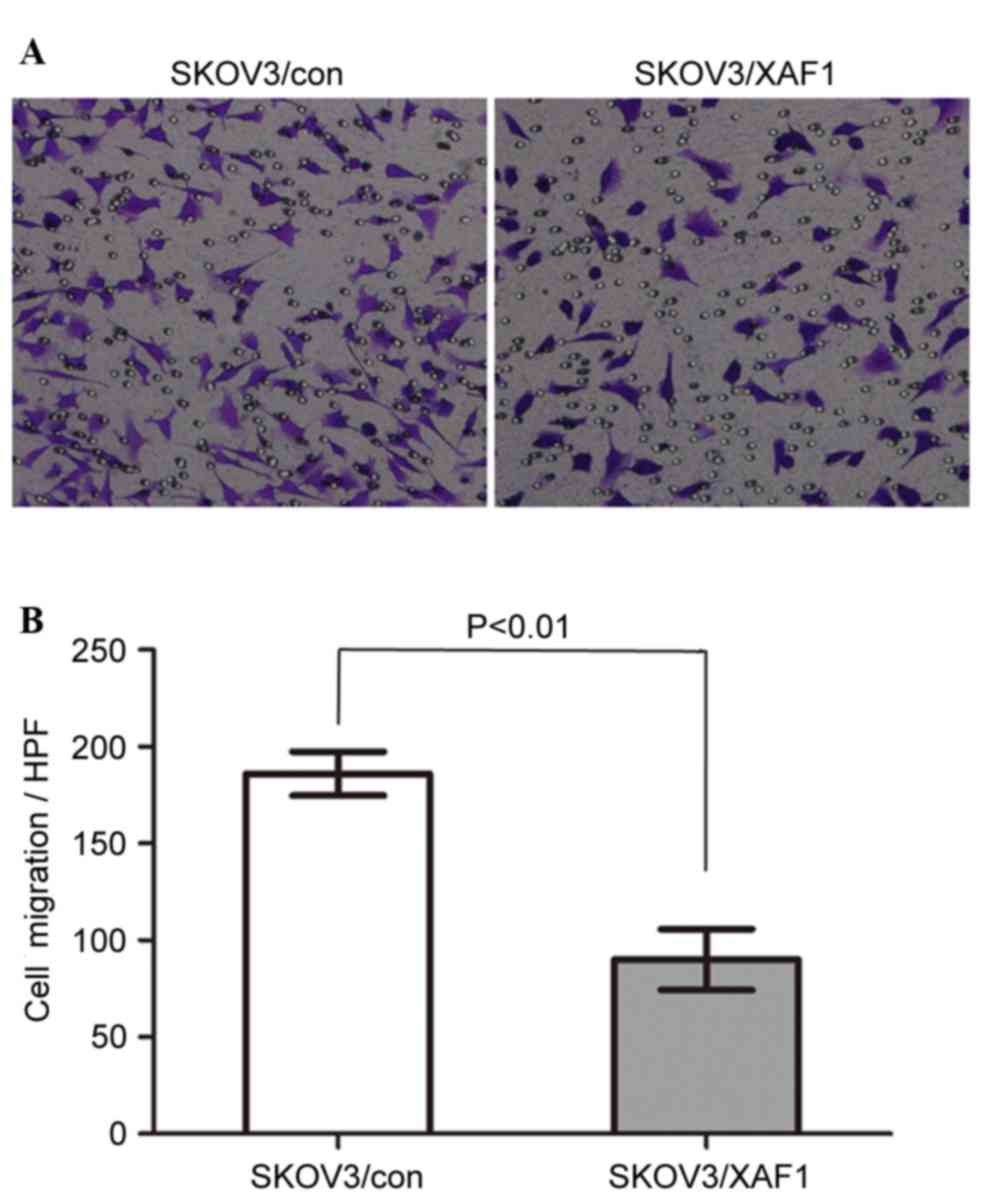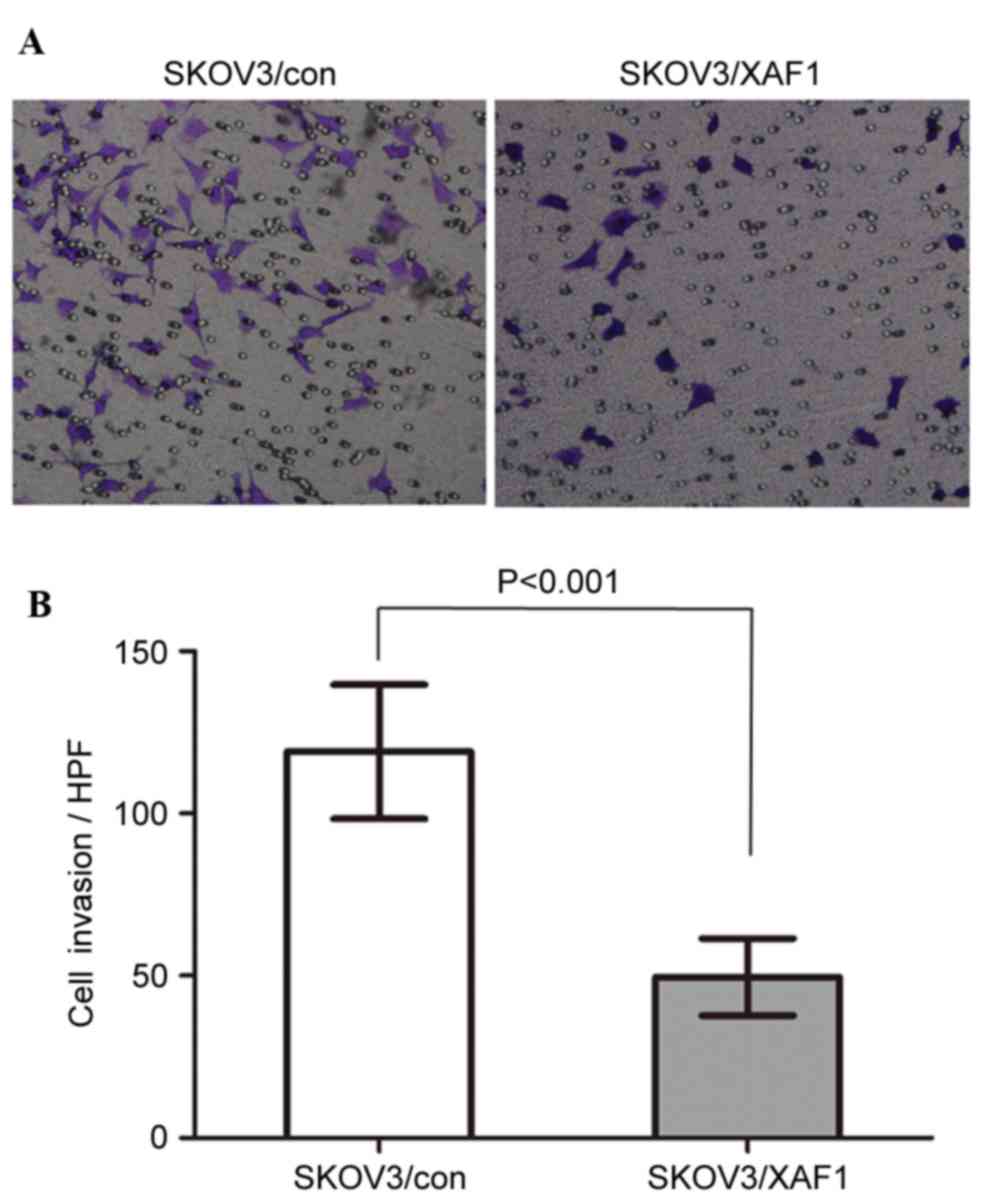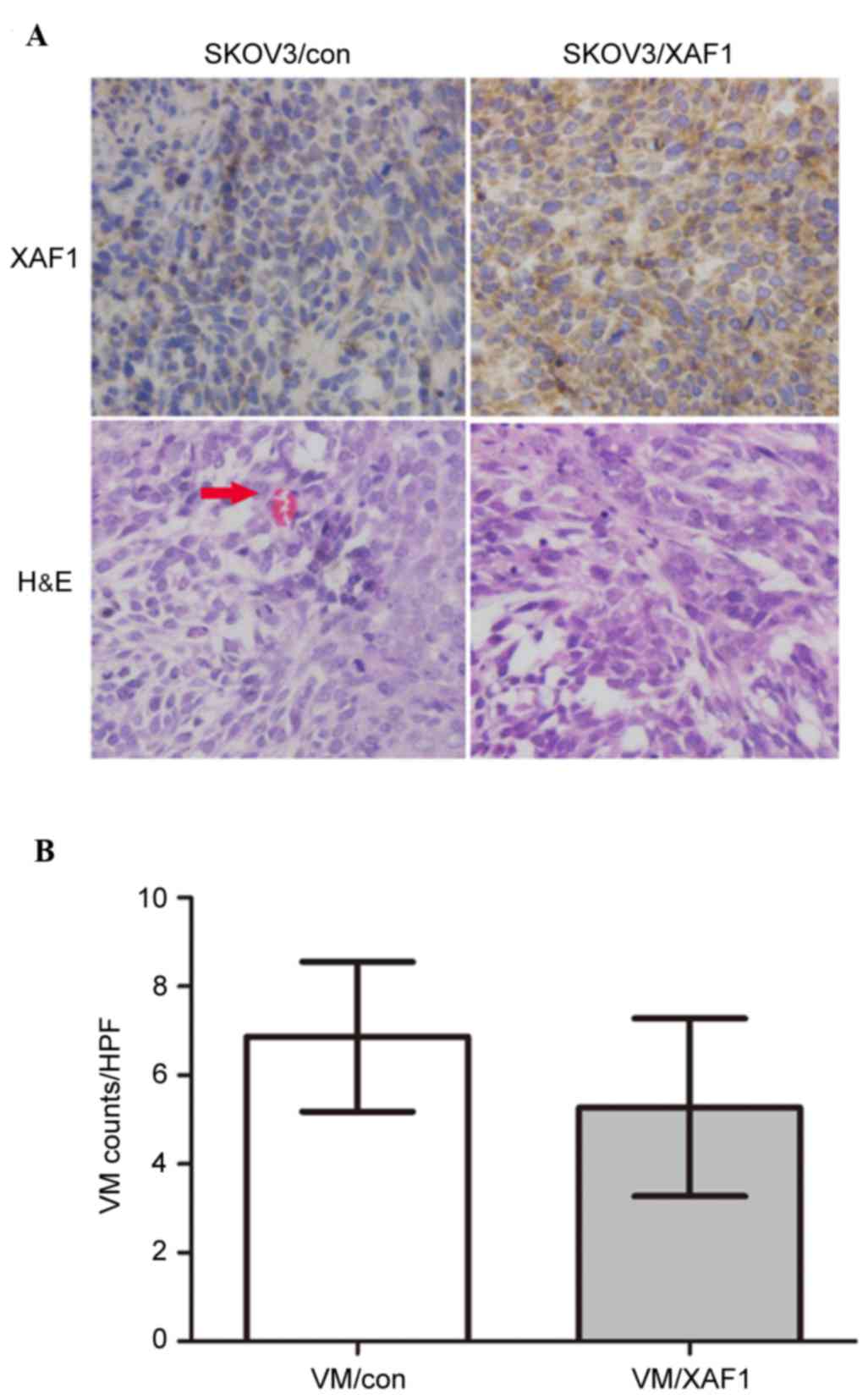Role of X‑linked inhibitor of apoptosis‑associated factor‑1 in vasculogenic mimicry in ovarian cancer
- Authors:
- Published online on: May 17, 2017 https://doi.org/10.3892/mmr.2017.6597
- Pages: 325-330
Abstract
Introduction
Apoptosis is a complex biological process relying on the balance between pro- and anti-apoptotic factors. One of the key regulators of apoptosis belongs to a family of proteins known as inhibitor of apoptosis (IAP). Of the known IAPs, X-linked inhibitor of apoptosis (XIAP) protein is the best characterized and most potent inhibitor of apoptosis. It blocks the apoptotic signaling pathway by binding and inhibiting caspase-3, -7 and -9 (1,2). XAF1 (XIAP-associated factor 1) was first isolated by the yeast two-hybrid technique and was identified as a novel XIAP binding partner that may reverse the anti-apoptotic effect of XIAP (3). Previous studies have demonstrated that XAF1 expression levels markedly decreased in a significant number of cancer cell lines (4) and a variety of cancers (5,6). It sensitizes cells to apoptotic triggers including tumor necrosis factor-related apoptosis inducing ligand (7), etoposide treatments, 5-fluorouracil, H2O2, tumor necrosis factor-α (8) and cisplatin (9,10). Besides anti-apoptotic effects, ectopic overexpression of XAF1 was reported to suppress migration and tube formation of mouse endothelial cells in vitro (11), and inhibit angiogenesis and tumor growth in hepatocellular carcinoma (12). In addition, it has recently been reported that XAF1 is involved in regulating the balance between autophagy and apoptosis in dengue virus type-2-infected endothelial cells (13).
For years, sprouting angiogenesis has been considered an exclusive underlying mechanism of tumor vascularization. In 1999, Maniotis et al (14) described the channels formed by highly aggressive melanoma cells. The term vasculogenic mimicry (VM) was used to describe the formation of these channels, which do not form from pre-existing vessels but supply blood to tumor cells. Furthermore, the tumor cells lining the inner surface of the channels are directly exposed to the blood flow. Detachment of these tumor cells enables them to reach the blood stream and metastasize to other organs (15). Immunohistochemistry revealed that VM existed in ovarian carcinoma and correlated with increased incidence of metastases and a reduced survival rate (16). This may be a reason why angiogenesis-targeted therapy strategies have limited efficacy in the treatment of ovarian cancer (17). Vartanian et al (18) provided experimental evidence that capillary-like structure formation requires apoptotic cell death via activation of caspase-dependent mechanisms. Their results suggested that apoptotic signaling pathways may be involved in the formation of VM. The present study investigated the expression of XAF1 in 94 advanced epithelial ovarian cancer (EOC) specimens and assessed whether it was associated with VM. The potential involvement of XAF1 in regulating proliferation, migration and invasion of ovarian cancer cells was additionally examined. Our previous research demonstrated that low XAF1 expression levels was significantly associated with high microvessel density in ovarian cancer tissues (19). The underlying mechanism by which XAF1 expression mediates angiogenesis of ovarian cancer cells will be elucidated.
Materials and methods
Tissue samples and cell lines
Formalin-fixed, paraffin-embedded tissues were obtained from the Department of Pathology of Qilu Hospital, Shandong University (Jinan, China). All patients received no treatment prior to surgery. EOC diagnosis was determined by two staff pathologists in the Department of Pathology. Specimens taken from 94 patients with stage II–IV EOC who received cisplatin-based combination chemotherapy following surgery were selected for analysis. The protocol was approved by the Ethics Committee of Shandong University and all patients were required to provide written informed consent prior to inclusion. Patient anonymity was preserved.
The SKOV3 human ovarian cancer cell line was purchased from the American Type Culture Collection (Manassas, VA, USA) and maintained in McCoy's 5A medium supplemented with 10% fetal bovine serum (both Gibco; Thermo Fisher Scientific, Inc., Waltham, MA, USA).
Immunohistochemistry and scoring
Following deparaffinization and antigen unmasking, sections were incubated in H2O2 for 10 min to inhibit endogenous peroxidase activity, and treated with goat serum (BOSS&Bio Co., Ltd., Beijing, China) for 30 min. Following this, they were incubated with anti-XAF1 (1:500; cat. no. ab17204; Abcam, Cambridge, UK) and anti-cluster of differentiation (CD)31 (1:200; cat. no. ab32457; Abcam) primary antibodies overnight at 4°C. Sections were incubated with the corresponding horseradish peroxidase-conjugated secondary antibody (1:200; cat. no. SAP-9101; Zhongshan Jinqiao Biotechnology Co., Ltd., Beijing, China) for 1 h and subsequently incubated for 2 min at room temperature with 3,3′-diaminobenzidine. Brown-yellow staining of the cytoplasm, cytoplasmic membrane and cell nucleus was considered positive. The staining was scored by 2 pathologists independently: 0 (≤5% positive tumor cells), 1 (6–25% positive tumor cells), 2 (26–50% positive tumor cells), and 3 (>51% positive tumor cells). Staining intensity was graded according to the following criteria: 0 (no staining), 1 (weak staining=light yellow), 2 (moderate staining=yellow brown), and 3 (strong staining=brown). The staining index was calculated as the product of staining intensity score and the proportion of positive tumor cells. A staining index score of >4 was used to define tumors with high expression levels of XAF1 and CD31, and a staining index score of <3 was used to indicate low expression levels (20).
CD31/periodic acid-Schiff (PAS) double staining and evaluation of VM
Following CD31 immunohistochemical staining, sections were treated with 0.5% periodic acid solution for 10 min and rinsed with distilled water for 2–3 min. Sections were subsequently incubated in Schiff solution for 15–30 min, rinsed with distilled water and counterstained with hematoxylin. VM was defined as channels surrounded by tumor cells with PAS-positive materials and red blood cells, while CD31 staining was negative (21).
Reverse transcription-polymerase chain reaction (RT-PCR)
Total RNA was extracted using Trizol (Thermo Fisher Scientific, Inc.). A total of 500 ng total RNA per sample was reversed transcribed to cDNA using PrimeScript™ RT Master Mix (Takara Biotechnology Co., Ltd., Dalian, China), according to the manufacturer's instructions. PCR was performed using SYBR-Green Real time PCR Master Mix (Toyobo Co., Ltd., Osaka, Japan) for 40 cycles of 95°C for 5 sec, 58°C for 10 sec and 72°C for 15 sec. Primer sequences were as follows: XAF1, forward 5′-CTCGGTGTGCAGGAACTGTAAA-3′ and reverse 5′-CAGGAACCGCAGGCAGTAA-3′; and β-actin, forward 5′-CCAACCGCGAGAAGATGA-3′ and reverse 5′-CCAGAGGCGTACAGGGATAG-3′. All primers were synthesized by Sangon Biotech Co., Ltd. (Shanghai, China). The specificity of PCR products was confirmed by melting curve analysis. Products were separated on a 1.5% agarose gel, visualized and imaged under ultraviolet light.
Plasmids and transfection
A pcDNA3-HA-XAF1 plasmid was provided by Dr Douglas W Leaman of the University of Toledo (Toledo, OH, USA). SKOV3 cells were transfected with either the parent vector [SKOV3/control (Con)] or pcDNA3-HA-XAF1 (SKOV3/XAF1) using Lipofectamine® 2000 (Invitrogen; Thermo Fisher Scientific, Inc.). The cells were incubated at 37°C in a 5% CO2 incubator for 48 h, following which 800 µg/ml geneticin (G418; Invitrogen; Thermo Fisher Scientific, Inc.) was added.
Migration and invasion assays
Cells at a density of 4×104 suspended in serum-free McCoy's 5A medium (Gibco; Thermo Fisher Scientific, Inc.) were seeded into inserts of Transwell chambers without Matrigel. The top chamber contained 0.2% bovine serum albumin with 10% FBS in the bottom chamber. The plate was incubated for 24 h at 37°C. Migrating cells on the bottom of the filters were fixed and stained with 0.5% crystal violet for 20 min. All experiments were performed at least in triplicate.
A cell invasion assay was performed using 24-well BioCoat Matrigel Invasion Chambers (BD Biosciences, Franklin Lakes, NJ, USA). A total of 5×104 cells were seeded into the upper chamber, and 600 ml of McCoy's 5A medium supplemented with 20% FBS was added into the lower chamber. Once cells were cultured in 5% CO2 at 37°C for 24 h, cells that had migrated through the Matrigel were fixed and stained with 0.5% crystal violet. All experiments were performed at least in triplicate.
Western blot analysis
Total protein was extracted from cells using radioimmunoprecipitation assay lysis buffer containing 1% protease inhibitors for 5 min (Beyotime Institute of Biotechnology, Shanghai, China). Proteins samples (50 µg) were separated by 10% SDS-PAGE and then transferred to a polyvinylidene fluoride membrane (Merck KGaA, Darmstadt, Germany). Membranes were incubated with primary antibodies for 2 h at room temperature, washed twice for 10 min, and then incubated with secondary antibodies for 10 min at room temperature. Primary antibodies targeting the vascular endothelial growth factor (VEGF; 1:1,000; cat. no. sc-7269) and β-actin (1:1,000; cat. no. sc-47778; loading control) were purchased from Santa Cruz Biotechnology, Inc. (Dallas, TX. USA). Horseradish peroxidase labeled anti-mouse or anti-rabbit secondary antibodies (1:2,000; cat. nos. ZB-2301 and ZB2307, respectively) were purchased from Zhongshan Jinqiao Biotechnology Co., Ltd. Blots were developed using enhanced chemiluminescence reagent (Super ECL Plus; Applygen Technologies, Inc., Beijing, China).
Tumor xenograft growth
SKOV3/Con and SKOV3/XAF1 cells (107) in 0.1 ml saline were implanted subcutaneously into the dorsal flank of 6-week-old female BALB/c-nude mice (n=15/group) from the Shanghai Experimental Animals Centre of the Chinese Academy of Sciences (Shanghai, China). All animal studies were carried out under approved guidelines of the Animal Care and Use Committee of Shandong University. Tumor dimensions were measured with a caliper and the volume was calculated using the formula V=axb2x0.5 (22) (a=length, b=width of prolate spheroid). Mice were euthanized and tumors collected after 6 weeks. Tumor sections were processed for immunohistochemistry and hematoxylin and eosin staining.
Statistical analysis
SPSS software version 13.0 (SPSS, Inc., Chicago, IL, USA) was used for statistical analysis. Data are present as the mean ± standard deviation. Differences between groups were evaluated using Student's t-test. P<0.05 was considered to indicate a statistically significant difference.
Results
Association between VM and clinical data in EOC
VM describes the formation of fluid-conducting channels by highly invasive and genetically deregulated tumor cells. As presented in Fig. 1A, VM was identified by the presence of red blood cells in vessels lined by tumor cells (without endothelial cells). A total of 35 (37.2%) EOC samples were VM positive. CD31 was stained positive in blood vessels (Fig. 1B).
The association of VM with the clinical data of the 94 EOC samples is presented in Table I. Presence of VM was associated with increased histological grade (P=0.030), an International Federation of Gynecology and Obstetrics (FIGO) stage between III and IV (P=0.098), and a serous histological type (P=0.124).
Association between XAF1 expression levels and VM in EOC sections
Staining of XAF1 was predominantly located in the cytoplasm of epithelium cells. A total of 37 of 94 (39.4%) of the samples demonstrated increased protein expression levels of XAF1 (Fig. 1C and D).
Reduced XAF1 expression levels were significantly associated with presence of VM. XAF1 expression was reduced in 30 of the 35 (85.7%) samples in the VM-positive group and in 27 of the 59 (45.8%) samples in the VM-negative group (P<0.01). As presented in Fig. 1E, the mean score of XAF1 expression was reduced in the VM-positive group compared with the VM-negative group (2.66±2.18 vs. 3.76±2.65, respectively; P=0.040).
XAF1 overexpression inhibits migration and invasion of SKOV3 cells
The effect of XAF1 on the motility of ovarian cancer cells was measured by Transwell migration assays (Fig. 2A and B). SKOV3/XAF1 cells that migrated through the filter were reduced significantly compared with the control group. The mean cell count migrated filter membrane was 122.0±35.64 for SKOV3/Con cells and 58.00±13.04 for SKOV3/XAF1 cells in one high power field (P<0.01).
The number of SKOV3/XAF1 cells invaded through the Matrigel-coated filter was reduced compared with control cells (Figs. 3A and B). The mean cell count invaded through the filter was 119.0±20.74 vs. 49.60±11.89 per field for SKOV3/Con and SKOV3/XAF1 cells, respectively (P<0.001).
XAF1 decreases tumor vasculature in vivo
Whether ectopic overexpression of XAF1 decreases tumor vasculature in vivo was examined. SKOV3/Con and SKOV3/XAF1 cells were implanted subcutaneously into BALB/c-nude mice. Tumor volume was monitored every week for up to 6 weeks. By week 6, mice implanted with control cells exhibited 2-3-fold larger tumors (data not shown) compared with those implanted with transfected cells. Immunohistochemistry demonstrated that XAF1 expression was increased in tumor xenografts derived from XAF1-overexpressing cells compared with those from vector control cells (Fig. 4A). Tumor xenografts formed from SKOV3/XAF1 cells exhibited significantly fewer VM channels compared with those formed from vector controls cells (Fig. 4B; P=0.037).
XAF1 overexpression inhibits VEGF protein expression
VEGF protein expression levels were examined in SKOV3 cells and tumor-bearing mice. XAF1 overexpression resulted in reduced protein expression levels of VEGF in SKOV3/XAF1 cells (Fig. 5A) and mice tumor tissues (Fig. 5B).
Discussion
There are three types of blood supply for cancer: VM, mosaic vessels and endothelium-dependent vessels. VM provides a pathway for perfusion independent of angiogenesis. The presence of VM characteristic structures in patient tumor tissues is associated with a poor clinical outcome, suggesting a functional contribution of these networks to tumor progression including ovarian cancer (16,23–25), and increased VM channels are associated with poorly differentiated ovarian cancer cells. Poorly differentiated tumor cells have been demonstrated to have plasticity and alter their cell markers and functions in order to adapt to a specific microenvironment (26–28).
Aggressive tumor features contribute to formation of tumor cell-lined vasculature in ovarian cancer (29). Our previous study demonstrated that reduced XAF1 expression was correlated with a high grade of advanced EOC (19). The present study demonstrated an association between incidence of VM and reduced expression of XAF1; the incidence of VM was significantly increased in XAF1-underexpressing samples. This provides a novel fundamental mechanism for an effect reported previously that decreased XAF1 expression is associated with poor prognosis in numerous types of cancers (30,31).
Restoration of XAF1 expression levels has been demonstrated to inhibit cell growth of pancreatic cancer (32), and migration and invasion of mouse endothelial cells (11). However, this effect on tumor cells has rarely been reported in previous studies. Using a plasmid-transfection approach, the present study investigated the direct effect of ectopic overexpression of XAF1 on the SKOV3 ovarian cancer cell line. In present study, proliferation, migration and invasion of SKOV3 cells were inhibited by overexpression of XAF1. This suggested that aggressive tumor cells serve an important role in VM formation. Consistent with this, a previous study demonstrated that poorly invasive tumor cells did not create these networks under identical culture conditions, even following the addition of conditioned media from aggressive cell lines (14).
In the present study, XAF1 overexpression resulted in reduced protein expression of VEGF in SKOV3/XAF1 cells and mouse tumor tissues. XAF1 has previously been demonstrated to inhibit angiogenesis and suppress expression of VEGF in hepatocellular carcinoma (12), and is known to be important in VM formation. A previous study revealed that VEGF-silencing induced apoptosis, inhibited proliferation and suppressed VM in osteosarcoma in vitro (33). Therefore, XAF1 may inhibit vasculature by suppressing VEGF expression in ovarian cancers.
In conclusion, the present study investigated the association between XAF1 expression with VM channels in EOC. Ectopic overexpression of XAF1 was demonstrated to suppress migration and invasion of SKOV3 cells. These findings may facilitate the development of novel therapeutic agents for the treatment of ovarian cancer.
Acknowledgements
The authors would like to thank Dr Douglas W. Leaman of the University of Toledo (Toledo, OH, USA) for the provision of the pcDNA3-HA-XAF1 plasmid.
References
|
Deveraux QL, Takahashi R, Salvesen GS and Reed JC: X-linked IAP is a direct inhibitor of cell-death proteases. Nature. 388:300–304. 1997. View Article : Google Scholar : PubMed/NCBI | |
|
Srinivasula SM, Hegde R, Saleh A, Datta P, Shiozaki E, Chai J, Lee RA, Robbins PD, Fernandes-Alnemri T, Shi Y and Alnemri ES: A conserved XIAP-interaction motif in caspase-9 and Smac/DIABLO regulates caspase activity and apoptosis. Nature. 410:112–116. 2001. View Article : Google Scholar : PubMed/NCBI | |
|
Liston P, Fong WG, Kelly NL, Toji S, Miyazaki T, Conte D, Tamai K, Craig CG, McBurney MW and Korneluk RG: Identification of XAF1 as an antagonist of XIAP anti-Caspase activity. Nat Cell Biol. 3:128–133. 2001. View Article : Google Scholar : PubMed/NCBI | |
|
Fong WG, Liston P, Rajcan-Separovic E, St Jean M, Craig C and Korneluk RG: Expression and genetic analysis of XIAP-associated factor 1 (XAF1) in cancer cell lines. 70:113–122. 2000. | |
|
Xing Z, Yu R, Li S and Liu Z: Regulatory effects of somatostatin on XAF1 in prostate cancer. Regul Peptides. 164:472010. View Article : Google Scholar | |
|
Kempkensteffen C, Fritzsche FR, Johannsen M, Weikert S, Hinz S, Dietel M, Riener MO, Moch H, Jung K, Krause H, et al: Down-regulation of the pro-apoptotic XIAP associated factor-1 (XAF1) during progression of clear-cell renal cancer. BMC Cancer. 9:2762009. View Article : Google Scholar : PubMed/NCBI | |
|
Leaman DW, Chawla-Sarkar M, Vyas K, Reheman M, Tamai K, Toji S and Borden EC: Identification of X-linked inhibitor of apoptosis-associated factor-1 as an interferon-stimulated gene that augments TRAIL Apo2L-induced apoptosis. J Biol Chem. 277:28504–28511. 2002. View Article : Google Scholar : PubMed/NCBI | |
|
Tu SP, Sun YW, Cui JT, Zou B, Lin MC, Gu Q, Jiang SH, Kung HF, Korneluk RG and Wong BC: Tumor Suppressor XIAP-Associated factor 1 (XAF1) cooperates with tumor necrosis factor-related apoptosis-inducing ligand to suppress colon cancer growth and trigger tumor regression. Cancer. 116:1252–1263. 2010. View Article : Google Scholar : PubMed/NCBI | |
|
Ju WC, Huang GB, Luo XY, Ren WH, Zheng DQ, Chen PJ, Lou YF and Li B: X-linked inhibitor of apoptosis-associated factor l (XAFl) enhances the sensitivity of colorectal cancer cells to cisplatin. Med Oncol. 31:2732014. View Article : Google Scholar : PubMed/NCBI | |
|
Ma B and Wang Y, Zhou X, Huang P, Zhang R, Liu T, Cui C, Liu X and Wang Y: Synergistic suppression effect on tumor growth of hepatocellular carcinoma by combining oncolytic adenovirus carrying XAF1 with cisplatin. J Cancer Res Clin Oncol. 141:419–429. 2015. View Article : Google Scholar : PubMed/NCBI | |
|
Qiao L, Gu Q, Dai Y, Shen Z, Liu X, Qi R, Ma J, Zou B, Li Z, Lan HY and Wong BC: XIAP-associated factor 1 (XAF1) suppresses angiogenesis in mouse endothelial cells. Tumour Biol. 29:122–129. 2008. View Article : Google Scholar : PubMed/NCBI | |
|
Zhu LM, Shi DM, Dai Q, Cheng XJ, Yao WY, Sun PH, Ding Y, Qiao MM, Wu YL, Jiang SH and Tu SP: Tumor suppressor XAF1 induces apoptosis, inhibits angiogenesis and inhibits tumor growth in hepatocellular carcinoma. Oncotarget. 5:5403–5415. 2014. View Article : Google Scholar : PubMed/NCBI | |
|
Huang J, Li Y, Qi Y, Zhang Y, Zhang L, Wang Z, Zhang X and Gui L: Coordinated regulation of autophagy and apoptosis determines endothelial cell fate during Dengue virus type 2 infection. Mol Cell Biochem. 397:157–165. 2014. View Article : Google Scholar : PubMed/NCBI | |
|
Maniotis AJ, Folberg R, Hess A, Seftor EA, Gardner LM, Pe'er J, Trent JM, Meltzer PS and Hendrix MJ: Vascular channel formation by human melanoma cells in vivo and in vitro: Vasculogenic mimicry. Am J Pathol. 155:739–752. 1999. View Article : Google Scholar : PubMed/NCBI | |
|
Folberg R and Maniotis AJ: Vasculogenic mimicry. APMISAPMIS. 112:508–525. 2004. View Article : Google Scholar | |
|
Gao Y, Zhao X, Gu Q, Wang JY, Zhang SW, Zhang DF, Wang XH, Zhao N, Gao YT and Sun BC: Correlation of vasculogenic mimicry with clinicopathologic features and prognosis of ovarian carcinoma. Zhonghua Bing Li Xue Za Zhi. 38:585–589. 2009.(In Chinese). PubMed/NCBI | |
|
Tang HS, Feng YJ and Yao L: Angiogenesis, vasculogenesis, and vasculogenic mimicry in ovarian cancer. Int J Gynecol Cancer. 19:605–610. 2009. View Article : Google Scholar : PubMed/NCBI | |
|
Vartanian AA, Burova OS, Stepanova EV and Baryshnikov AY: The involvement of apoptosis in melanoma vasculogenic mimicry. Melanoma Res. 17:1–8. 2007. View Article : Google Scholar : PubMed/NCBI | |
|
Wang Y, Mao H, Hao Q, Wang Y, Yang Y, Shen L, Huang S and Liu P: Association of expression of XIAP-associated factor 1 (XAF1) with clinicopathologic factors, overall survival, microvessel density and cisplatin-resistance in ovarian cancer. Regul Pept. 178:36–42. 2012. View Article : Google Scholar : PubMed/NCBI | |
|
Zhao ZS, Chu YQ, Ye ZY, Wang YY and Tao HQ: Overexpression of matrix metalloproteinase 11 in human gastric carcinoma and its clinicopathologic significance. Hum Pathol. 41:686–696. 2010. View Article : Google Scholar : PubMed/NCBI | |
|
Sood AK, Seftor EA, Fletcher MS, Gardner LM, Heidger PM, Buller RE, Seftor RE and Hendrix MJ: Molecular determinants of ovarian cancer plasticity. Am J Pathol. 158:1279–1288. 2001. View Article : Google Scholar : PubMed/NCBI | |
|
Naito S, von Eschenbach AC, Giavazzi R and Fidler IJ: Growth and metastasis of tumor cells isolated from a human renal cell carcinoma implanted into different organs of nude mice. Cancer Res. 46:4109–4115. 1986.PubMed/NCBI | |
|
Baeten CI, Hillen F, Pauwels P, de Bruine AP and Baeten CG: Prognostic role of vasculogenic mimicry in colorectal cancer. Dis Colon Rectum. 52:2028–2035. 2009. View Article : Google Scholar : PubMed/NCBI | |
|
Liu XM, Zhang QP, Mu YG, Zhang XH, Sai K, Pang JC, Ng HK and Chen ZP: Clinical significance of vasculogenic mimicry in human gliomas. J Neurooncol. 105:173–179. 2011. View Article : Google Scholar : PubMed/NCBI | |
|
Shirakawa K, Wakasugi H, Heike Y, Watanabe I, Yamada S, Saito K and Konishi F: Vasculogenic mimicry and pseudo-comedo formation in breast cancer. Int J Cancer. 99:821–828. 2002. View Article : Google Scholar : PubMed/NCBI | |
|
Folberg R, Hendrix MJ and Maniotis AJ: Vasculogenic mimicry and tumor angiogenesis. Am J Pathol. 156:361–381. 2000. View Article : Google Scholar : PubMed/NCBI | |
|
Zhu P, Ning Y, Yao L, Chen M and Xu C: The proliferation, apoptosis, invasion of endothelial-like epithelial ovarian cancer cells induced by hypoxia. J Exp Clin Cancer Res. 29:1242010. View Article : Google Scholar : PubMed/NCBI | |
|
Su M, Feng YJ, Yao LQ, Cheng MJ, Xu CJ, Huang Y, Zhao YQ and Jiang H: Plasticity of ovarian cancer cell SKOV3ip and vasculogenic mimicry in vivo. Int J Gynecol Cancer. 18:476–486. 2008. View Article : Google Scholar : PubMed/NCBI | |
|
Sood AK, Fletcher MS, Zahn CM, Gruman LM, Coffin JE, Seftor EA and Hendrix MJ: The clinical significance of tumor cell-lined vasculature in ovarian carcinoma: Implications for anti-vasculogenic therapy. Cancer Biol Ther. 1:661–664. 2002. View Article : Google Scholar : PubMed/NCBI | |
|
Ling ZQ, Lv P, Lu XX, Yu JL, Han J, Ying LS, Zhu X, Zhu WY, Fang XH, Wang S and Wu YC: Circulating methylated XAF1 DNA indicates poor prognosis for gastric cancer. PLoS One. 8:e671952013. View Article : Google Scholar : PubMed/NCBI | |
|
Kim SK, Park HJ, Seok H, Jeon HS, Kim JW, Chung JH, Kwon KH, Woo SH, Lee BW and Baik HH: Missense polymorphisms in XIAP-associated factor-1 (XAF1) and risk of papillary thyroid cancer: Correlation with clinicopathological features. Anticancer Res. 33:2205–2210. 2013.PubMed/NCBI | |
|
Huang J, Yao W, Zhu Q, Tu SP, Yuan F, Wang HF, Zhang YP and Yuan YZ: XAF1 as a prognostic biomarker and therapeutic target in pancreatic cancer. Cancer Sci. 101:559–567. 2010. View Article : Google Scholar : PubMed/NCBI | |
|
Mei J, Gao Y, Zhang L, Cai X, Qian Z, Huang H and Huang W: VEGF-siRNA silencing induces apoptosis, inhibits proliferation and suppresses vasculogenic mimicry in osteosarcoma in vitro. Exp Oncol. 30:29–34. 2008.PubMed/NCBI |














